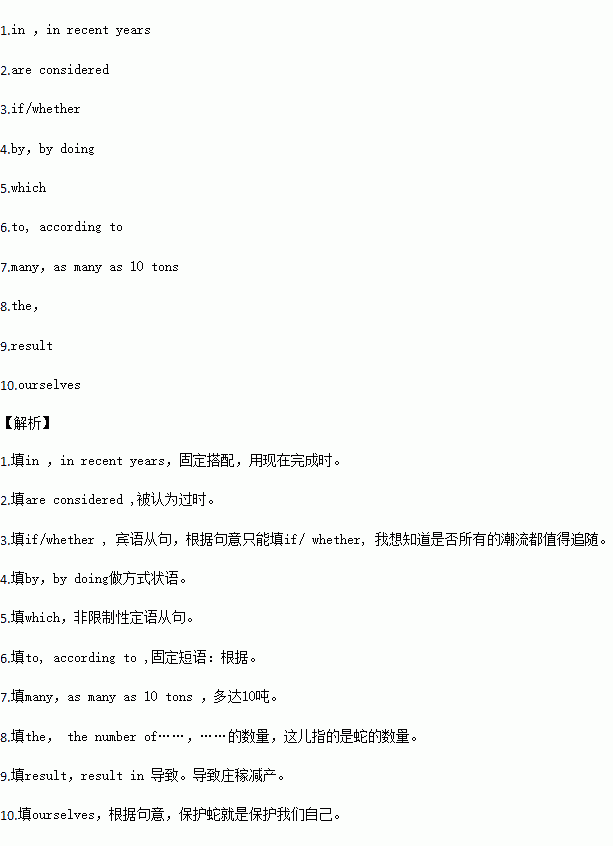题目内容
第二节(共10小题;每小题1.5分,满分15分)
阅读下面材料,在空白处填入适当的内容(不多于3个单词)或括号内单词的正确形式。
Snake dishes have become popular1. recent years. Snake meat in various flavors (风味) is often seen in restaurant ads. Eating snake seems to be now in vogue(盛行), and if you haven’t eaten snake yet, you 2.(consider) “out of date”. But I wonder3. all the trends are worth following.
Some people may defend themselves _4. saying that snake meat is nutritious. But these people don’t realize that many parasites(寄生虫),5. do harm to our health, are found inside snakes.
According 6. a survey, about 1000 tons of snakes are eaten every year in China and sometimes as 7. as 10 tons of snakes are served on dinner tables in Shenzhen in a single day!
These figures warns us that if no action is taken, 8. number of snakes will drop and make an increase in mice and worms population, which will 9.in a decrease(减产) of crop output. Who will see such tragedy happen?
So let’s start not to eat snakes any more because “to protect the snake is to protect 10.”
 阅读快车系列答案
阅读快车系列答案At Japan’s Studio Ghibli, which has produced extraordinary animated films(动画片)since 1985, the best-known figure has always been one of the company’s founders, Hayao Miyazaki.
But an equally key figure is co-founder Isao Takahata, who has recently made a new feature, The Tale of Princess Kagnya. It is an unforgettable feature with an unusual hand-drawn aesthetic(美感).
The title character is a tiny baby girl who appears in a bamboo plant. She is found by a woodcutter, who takes her home and brings her up. He believes the little girl is a princess, and sets about preparing what he regards as a suitable world for her.
This original story is the oldest work of fiction in Japan; every child knows it in its simplified folktale form.
“It is a fascinating story with elements of wonder, humour, and sorrow,’’ Takahata says, “but these three elements are scattered(分散)about.” The chief challenge for anyone trying to adapt it is that “we are completely unable to comprehend what was in the heart of Princess Kaguya. Because of this, despite its being well known, few people consider it interesting. There have been several attempts at making a film out of the story, but they ended up being abandoned.”
He was connected with one of these attempts, but no one paid any attention to his concept.
“Fifty-five years later, I thought my concept was still appealing, and used it as a basis for turning the story into a feature film.”
His concept involves the princess’s origins, her expectations and her access to “the full range of human emotions”.
To realize his vision, Takahata says, “I needed to take the extremely individualistic brushwork and key designs of Osamu Tanabe and Kazuo Oga, two brilliantly talented artists, and have them permeate(扩散)throughout the film. The two of them drew many pictures, but they weren’t nearly enough. The most challenging part was to have all the other animation staff copy their styles in a free and easy way.”
The Tale of Princess Kaguya has been released, and people are saying that the two founders, now in their seventies, have directed their final films. But is it as clear-cut as that? When I ask Takahata about a scene of escape and urgency with a particularly distinctive (独特的) visual style, he says he had intended to use “this type of rough-drawn, forceful animation, in a project before this film.
“That project hasn’t been realized yet, but if it comes to pass, this style is essential.”
A hint, perhaps, there's still more to come.
1.Which of the following choices has got the right match?
①Hayao Miyazaki | a. one of the founders of Studio Ghibli |
② Isao Takahata | b. fictional character |
③ Kazuo Oga | c. famous artist |
④ Princess Kaguya | d. animation staff member of The Tale of Princess Kaguya |
A.① d B. ② a C.③ b D.④ c
2.Why is it challenging to adapt the original story to a feature film according to the passage?
A. Because people are in the dark about the feelings of Princess Kaguya.
B. Because the story itself offers a combination of wonder, humour and sorrow.
C. Because the story is too old to appeal to the audience nowadays.
D. Because every Japanese has been familiar with the story ever since childhood
3.From the Takahata version of The Tale of Princess Kaguya, we can expect the following except ________.
A. more details about the Princess’s origins and expectations
B. a forceful animation type featuring fine images and gentle brushwork
C. the distinctive brushwork and key designs from two gifted artists
D. a hand-drawn visual effect that brings out a unique sense of beauty


